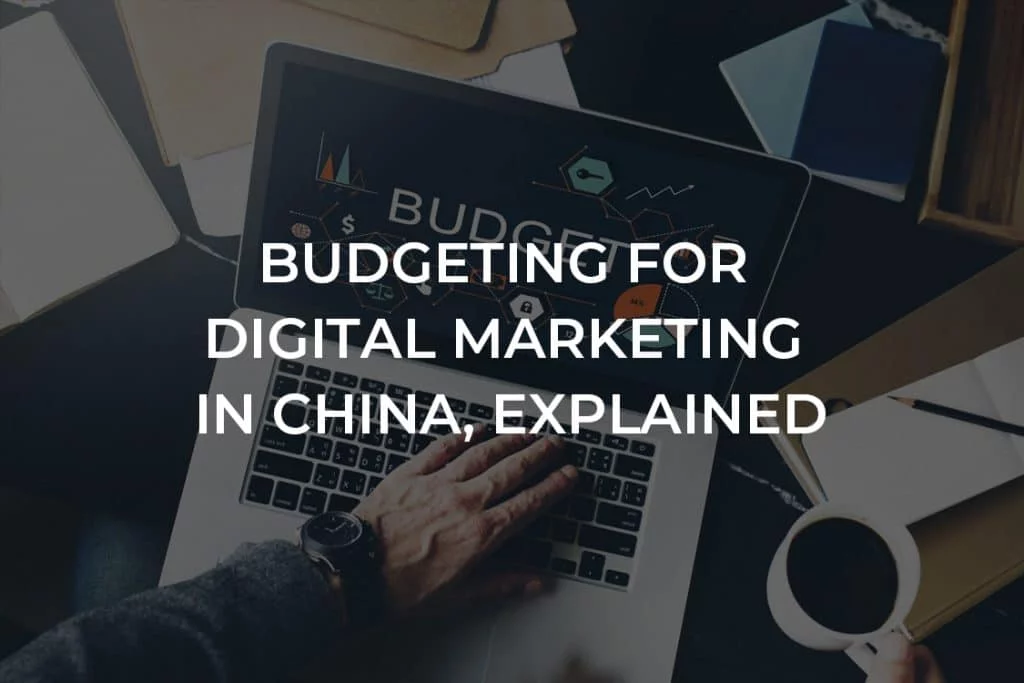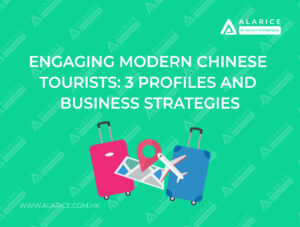One of the biggest issues brands encounter when entering China is that they grossly underestimate the budget needed for an effective marketing strategy. Without sufficient funding and/or incorrect budget allocation, they flounder, and fail to gain traction.
Why is this such a common problem? Possibly because money, budgeting, and costs are generally taboo topics that are spoken about vaguely in public, and only discussed in detail behind closed doors. With little concrete information out there, brands are struggling to know how to be allocating their marketing budgets, and what type of results to expect.
Underestimating the Cost and Overestimating the Return
Many brands entering China have great expectations, incorrectly believing that costs will be low, and rewards will be high. But the environment in China has radically changed over the past five to ten years, and brands still holding onto those expectations are likely to be disappointed.
“China does not equal cheap. Some clients underestimate the cost of marketing in China. They forget that it’s a massive country, comprised of many individual markets, geographies, and consumer types. In our experience, they also believe that costs should be cheaper than in the West. In fact, many times costs are on par or even more expensive than markets such as Europe or the US,” explained Nick Cakebread, Managing Partner at Reuter Communications, a luxury marketing and communications agency. “A simple example is the cost of some of the top-tier online influencers in China. They can easily be charging more than 50,000 USD per post. That surprises some clients.”
And not only are costs higher, but Return on Investment (ROI) is lower, “It’s common for foreign clients to have flawed expectations on ROI. They apply western standards and KPIs (Key Performance Indicators) to the China market and have an illusion that they can get the same results in China with the same budget they use in their home country. However, China is a much more competitive and expensive market than its counterparts. So, the ROI is lower, and they need to increase their marketing investment in order to grab market share,” explained Ashley Galina Dudarenok, Founder of resource and training company ChoZan and social media agency Alarice.
So, How Much Should Brands Expect to Spend?
Michael Lin, Business Director at Mailman X shared, “We focus on creating dedicated teams for our clients in China. For multinational brands, yearly budgets are typically around 100,000 USD on the low end and over 1,000,000 USD on the high end which can cover full digital scopes including SEM, PR, Website, Social, and Media. For a campaign or specific promotion, the budget will be dependent on which channels are used for promotion and what kind of audiences the brand is trying to reach.” He added, “but it’s important to remember, with any campaign, having a creative hook can be just as important as the total amount of budget allocated.”
Ashley Galina Dudarenok gave similar numbers, “In ballpark figures, an average yearly marketing budget for brands of different sizes would look something like this:
Very small: 25,000 USD – 100,000 USD
Small: 100,000 – 300,000 USD
Medium: 300, 000 – 1,000,000 USD
Large: 1,000,000 USD or above
In terms of launching a social media campaign, even a very small brand has to spend at least 15,000 USD. For a holiday promotion, it depends on the product category and the platform chosen, but the budget would be around 10,000 – 40,000 USD.
With the lack of information publicly available, Chinese influencer marketing agency PARKLU was being bombarded with brands asking about influencer rates in China, so much so that they decided to create a free KOL budget calculator. The calculator can produce estimates for top-tier down to micro influencers, across eleven social media platforms. Within a couple weeks of launching, the calculator has gained over 3,500 users.
It appears to be filling a need, with online users claiming, “I checked out PARKLU’s KOL budget calculator the other day and I think it’s one of the best ones I’ve seen like this. I wish more agencies would adapt this model.”
Allocating the Chinese Marketing Budget
All the experts Jing Daily spoke to agreed that China is far too complex for there to be a one-size fits all model, and budget allocation will depend on a number of factors. But they did give some recommendations and things to consider:
“Marketing should always be highly individualized and personalized – to the brand, the target audience, and to what the brand wants to achieve in the market. For some, a social media and influencer strategy may work extremely well. For others that want a much greater reach, mass advertising may be more effective. For highly niche, ultra-luxury brands, a targeted one-on-one or experiential strategy may deliver stronger returns,” explained Nick Cakebread.
Michael Lin feels that budget allocation is highly dependent on brand recognition or maturity in the Chinese market, “For lesser known brands in China, it may be better to allocate more budget into search and social to gauge consumer insights before investing in other more expensive media channels like KOLs, media buys, or more expensive social ads. For more popular brands, they can be more strategic on how they spend depending on their goals in market and what kind of target audience they are looking to reach. These types of big, well-known brands would have more luxury to spend across all avenues of digital marketing.”
While obviously not applicable to all brands, Ashley Galina Dudarenok shared an example budget, “Take a midsize lifestyle brand for instance, I might suggest they divide their budget like this: 30 percent on social (including content creation), 20- 30 percent on ads, 20-30 percent on influencers, 10 percent on search, and 10 percent on experiential.”
Where Are Spending Mistakes Happening?
This question drew a wide variety of responses and differing opinions, of course, all worth considering. One hot area of debate was influencer marketing.
Galina Dudarenok felt that some brands are overspending on big bloggers, while underspending on micro-influencers and online to offline (O2O) events, “Brands often focus on a blogger’s follower numbers and aim for as much potential reach as possible. Yet big bloggers are not always the best choice for marketing because their fan base is relatively broad. If brands want to target more niche markets, they should collaborate with micro-influencers whose followers would find their products most relevant. And as their follower base is not that huge, the engagement rate with the audience is usually higher and thus the audience is more loyal.”
She went on to share more about the importance of O2O events, “It is very important for brands to drive online traffic to offline stores where customers can physically interact with the brand and enjoy entertaining shopping experiences, so brands should invest in events connecting online and offline, such as livestreaming at brick-and-mortars.”
Kim Leitzes, CEO of PARKLU, had a slightly different view, at least when it comes to brands that are just entering the China market, “Contrary to general belief, if you are just entering the China market or are a new brand, you should initially spend a large portion of your marketing budget to collaborate with top-tier influencers. These influencers can instantly bring credibility and awareness to your brand, both among consumers and other smaller KOLs. Once they have heard of your brand, it will be easier to engage with mid-tier and micro-influencers on a large scale and will make product seeding more effective.”
But no matter what size influencers you work with, she feels that international brands should be allocating more of their marketing budget to KOL marketing, “In China, large (Chinese) companies spend 15-40 percent of their marketing budgets on KOLs, while small companies allocate much more, at about 50-80 percent.”
Nick Cakebread agrees that influencers are important, but, just like Galina Dudarenok, urged brands not to forget offline experiences, “In recent years, a lot of the discussion has been on digital, social and online influencers. Of course, this is the reality when it comes to where consumers are spending their time and the rise of digital commerce. However, I think some brands at times forget and under-invest when it comes to real-world brand and product experiences. Even many of the technology e-commerce players such as Alibaba, JD.com, and Amazon are investing in real-world brand and shopping experiences that complement the online experience.”
Some of the other areas that came up were websites, advertising, CRM, and WeChat vs. Weibo:
“One area that brands may tend to overspend is on maintaining their traditional websites. As user behavior is evolving, websites are increasingly becoming less and less relevant, especially with the emergence of WeChat mini-programs or even new channels, such as Douyin, that are able to influence rising consumers in a more creative way,” argued Michael Lin, “Websites are still important for certain brands, but may not have to be as sophisticated as they once were.”
Pablo Mauron, Managing Director of Digital Luxury Group China, touched on the fact that many brands overestimate the power of organic reach, and need to include budget for advertising to push their content to a wider audience, “The algorithms on social platforms in China are built in such a way that brands are forced to advertise because relying solely on organic reach simply will not generate enough exposure. Even if a brand has high-quality, creative content, it will not translate into numbers if the reach isn’t there. Likewise, high reach volume doesn’t mean anything if it is not paired with solid content. Viral campaigns may be the exception, but they represent a small fraction of a brand’s activities – if at all – and brands cannot merely rely on this.”
Lin also mentioned that lack of knowledge related to Chinese social platforms, primarily the roles and responsibilities of WeChat and Weibo, can lead to mismanagement of budget in China, “International clients will almost always gravitate towards WeChat as the premier social channel in China, just based on news stories about their 1 billion monthly active users. Their expectation is for their new WeChat channels to grow exponentially and quickly at a very low cost.
In reality, WeChat is a peer-peer network first, and it is becoming increasingly more expensive to gain followers as well as attract people to look at your content. Clients need to understand that, as the competition grows, so does the cost of marketing on the channel and average acquisition cost per follow on WeChat now currently hovers between 80-100RMB.
On the flip side, Weibo can be a very effective way to gain a marketing presence at a fraction of the cost in both content creation and media spend. Many international clients have a misconception of how important of a channel Weibo is to brands in terms of awareness and reach. Weibo is a true social media channel and its user numbers have been growing for over eight straight quarters, contrary to what most international clients believe.”
Nick Cakebread pointed out that with saturation and rising follower acquisition costs on many of the top platforms, brands need to start budgeting more for CRM strategies and programs, “We now have far more conversations with brands in this area. After many years focusing on customer acquisition, it’s now about customer retention and how they can sell more to existing customers.”
While far from being a definitive guide to creating budgets, these expert opinions can give brands food for thought, and help set more realistic expectations for China marketing strategies.
Disclaimer

This article <Budgeting for Digital Marketing in China, Explained> was originally published on Jing Daily, written by Lauren Hallanan.





